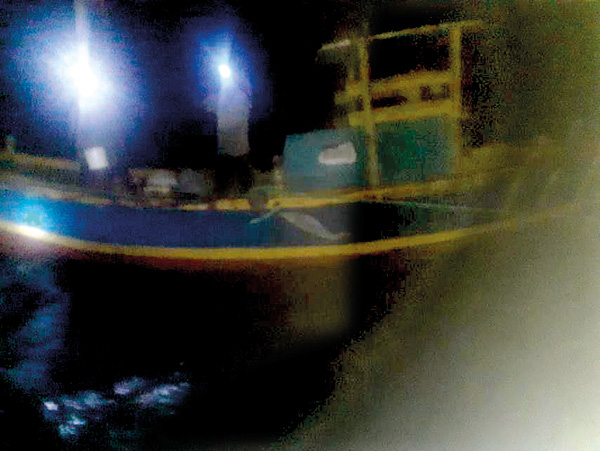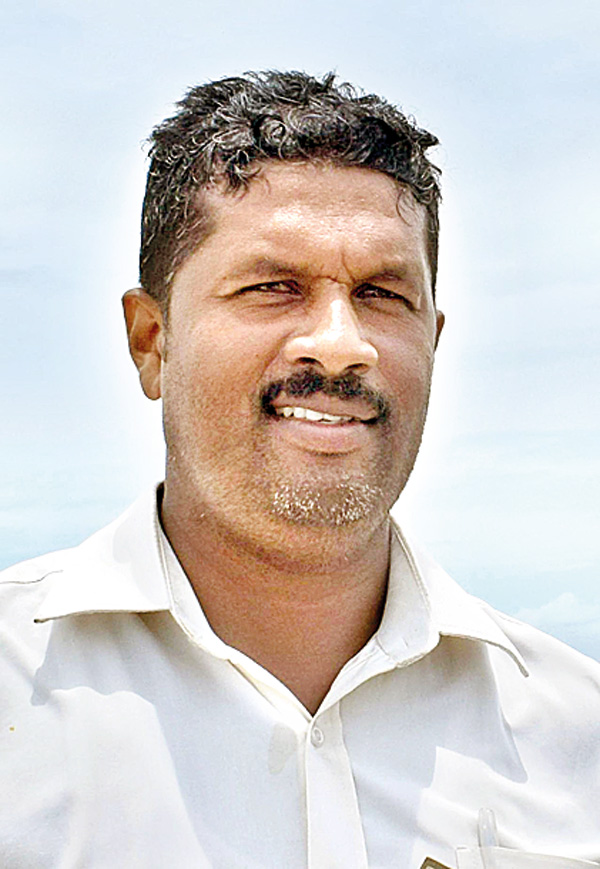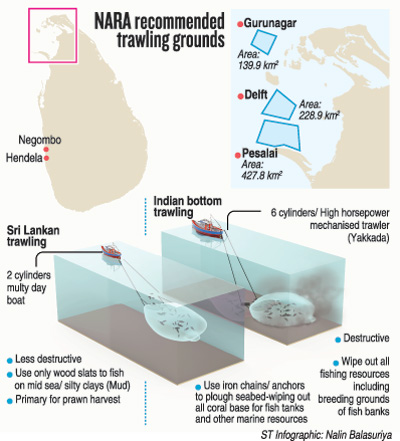News
Vallam fishermen distraught as Govt. bends to trawler demands
Last Monday at midnight, a group of fishermen from Eluvaitivu, one of the northern islands off Jaffna, ventured out to sea after noticing a group of local trawlers engaged in fishing a few kilometers offshore.

Picture taken by fishermen of local trawlers engaged in fishing close to Eluvaitheevu off Jaffna, last Monday
Last Monday at midnight, a group of fishermen from Eluvaitivu, one of the northern islands off Jaffna, ventured out to sea after noticing a group of local trawlers engaged in fishing a few kilometers offshore.
Usually, the fishermen keep an eye out for Indian bottom trawlers but this time they saw local trawlers coming from various parts of Jaffna.
The local fishermen decided to follow the trawlers, acting on an instruction coming from a meeting two days ago at the office of Fisheries Minister Douglas Devananda, who instructed fishermen to tip off local fisheries authorities and the navy with “evidence” if they see local trawlers operating near the coast.
“When we identified local trawlers operating just 500m away from the coast we immediately informed the local fisheries authorities, the Divisional Secretary and the navy but no action came,” Jesuthasan Kanislas, the leader of the Eluvaitivu St Thomas Fishermen Federation Union, told the Sunday Times.
“They continued trawling as we looked on. How can we take the law into our hands?”
Thousands of local fishermen who use traditional vallams, fibreglass boats, are vehemently opposed to illegal bottom trawling by Indian fishermen over the years – and now they find themselves in conflict with their own brethren.
Mr. Kanislas, who was among the fishermen watching the local trawlers on Monday, said there had been two dozen vessels at work, with powerful lights on. Some boats did not have a registration number painted on their sides.
“Allowing trawling by local fishermen poses a huge threat to the livelihood of our community as this illegal practice destroys the fishing breeding grounds, coral beds and other marine resources, depleting them completely,” Mr. Kanislas said.
“We use nine or 10-inch fishing nets commonly, whereas trawlers use two to three-inch nets to catch much smaller fish varieties.” He stressed that the significant reduction in the fish catch over the years was a good indication of depleted marine resources.
Weeks ago, according to Mr. Kanislas, Rs. 400,000 worth of fishing nets owned by local fishermen from his union had been destroyed by trawlers. Despite complaining to the authorities, no compensation was provided nor any probe launched over the incident.

Annalingam Annarasa
Fed up with the lukewarm attitude by officials, fishermen representatives took up the matter with the Prime Minister Mahinda Rajapaksa recently ahead of his online meeting with Indian Premier Narendra Modi, where the issue of Indian bottom trawling trespassers was on the agenda.
Annalingam Annarasa, the leader of the Kayts Fisheries Cooperatives Federation, who took part in the meeting with the Prime Minister at Temple Trees on September 25, raised the issue. Premier Rajapaksa assured him that he would look into the matter within two weeks.
“The owners of these trawlers register their boats as ordinary multi-day fishing boats but convert them to mechanised trawlers, with equipment such as winches and big masts, like those used by Indian fishermen for bottom-trawling,” Mr. Annarasa said, expressing grave concerns that the failure to act by authorities might lead to conflicts within northern fisherfolk communities.
Every day, more than 500 trawlers, registered as multi-day fishing vessels with permits, set off from Gurunagar for a bountiful trawling ground located between the islands of Analaitivu, Eluvaitivu and Delft in the northern sea, dismaying some 12,000 traditional fishermen.
Trawling is also actively pursued by fishermen in other districts in the north for its profits. There are hundreds of trawlers from Mannar, Valvettithurai, Vadamarachchi and Pesalai, Mannar whose owners successfully lobbied the Ministry of Fisheries to legalise the practice and identify potential trawling grounds.
During a meeting with fishermen representatives held recently on the issue, Minister of Fisheries Douglas Devananda regretted a decision he took some years ago.
He recalled how in the early 2000s he, then a cabinet minister, secured 43 trawler fishing permits for fishermen in Gurunagar, Jaffna which multiplied into more than 500 within a decade.
Nearly a year ago, the Fisheries Ministry commissioned the National Aquatic Resources Research and Development Agency (NARA), one of its research arms, to carry out a study to identify potential trawling grounds around the island in order to increase foreign exports.
Following a comprehensive field study, NARA recommended four trawling grounds, in Delft in Jaffna, Pesalai in Mannar, Negombo, and Hendala in Wattala, where a significant number of local trawlers currently operate without licences.
Recently, a group of Vadamarachchi fishermen met NARA officials and urged them, in the face of a strong protest by local fishermen, to allocate a dedicated sea region for trawling. A NARA team is scheduled to visit the identified regions in the coming weeks but its move has drawn criticism from the branch of the Federations of Rural Fishermen Communities in Vadamarachchi. 
In 2017, bottom trawling was banned in Sri Lanka with the passage of an amendment to the Fisheries and Aquatic Resources Act. The law makes it illegal to either fish from, operate, or own a boat engaged in bottom trawling. The offence carries a fine of Rs 50,000 and up to two years of imprisonment.
Foreign fishing vessels found to be engaged in bottom trawling in Sri Lanka’s waters face fines ranging from Rs 1 million to 100 million. The law also makes illegal the import of bottom trawling equipment.
NARA Chairman A. Navaratnerajah told The Sunday Times that, following disputes between fishermen using traditional methods and those using mechanised trawlers, NARA had been instructed to identify special areas for trawling.
He said some forms of trawling were allowed as they were less destructive compared to the bottom trawling practised by Indian fishermen whose nets scoop the seabed clear of all the rich marine resources.
In the northern seas, NARA recommended two designated trawling grounds: a 228 sq km area off Delft island and another 134 sq km off Analaitivu and Nainativu islands, with specific satellite coordinates for clear demarcation of the sea boundaries.
Local trawling is not as destructive to marine resources as bottom trawling by Indian fishermen, National Institute of Oceanography Marine Sciences at NARA and a member of the Expert Committee that studied trawling grounds, Dr. K. Arulananthan, told the Sunday Times.
“Any type of trawling is harmful to the sea; what varies is the degree of the trawling practice and mechanism used for the practice,” he said.
Pointing out that local fishing boats have two-cylinder engines compared with Indian fishing trawlers powered by six-cylinder engines, Dr. Arulananthan also said trawling nets used by local fishermen do not go all the way to the seabed as they use only wood block weights on their nets unlike the heavy iron chains and anchors used by Indian fishermen that allow their trawling nets to drag along the seabed.
“Local trawling can go down to the silty clays above the seabed, protecting the coral bases, fish breeding grounds and fish banks to a certain extent. Our fishermen cannot engage in bottom trawling due to the limited horsepower of their boats,” Dr. Arulananthan said.
In 2015, a NARA study into Indian bottom trawling in Sri Lankan waters revealed that out of 22kg of total catch only one kilogram could be used for human consumption.
Currently, the Fisheries Ministry is planning to legalise designated trawling grounds by gazetting the areas recommended by NARA and introducing a fresh amendment to the 2017 legislation that banned the practice.
“A final decision on this has to be taken by the Minister and approval by Cabinet is needed,” said Ginige Prasanna Janaka Kumara, Director-General of the Fisheries Department, which issues fishing permits.
As local fishermen are sceptical about whether trawling, with this permission, will be carried out within legal limits and would be satisfactorily monitored, the navy has said it would take adequate steps to ensure the practice is carried out in designated sea grounds using approved fishing equipment.
“As we are doing currently with those engaged in illegal fishing activities, we will arrest [wrongdoers], confiscate their fishing equipment and hand them over to the authorities for further legal action,” navy spokesperson Captain Indika de Silva said.
Prevented by the ongoing second wave of coronavirus from staging protests in several districts about the authorities’ failure to clamp down on illegal trawler fishing, northern traditional fisherfolk nevertheless vow they will press for a total ban on trawling at any cost.
“Indian fishermen come to our waters after they depleted the fish catch in their waters due to bottom trawling. Now, we too are heading towards such a scenario,” Mr. Annarasa said.
“The government has to act now or else, very soon, they will have to consider alternative jobs for us as there would be no fish left in our waters. Is that what we want?”

